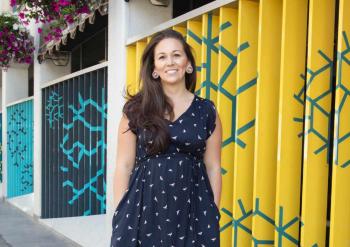Image Caption
By Stephanie Joe
Windspeaker.com Contributor
The new Central Public Library in Calgary is scheduled to open on Nov. 1, and with that there will be an unveiling of local Indigenous art installations meant to represent Treaty 7 First Nations.
The Calgary public libraries system recently had a call out for art works that are original, local and which will be permanently on display at the new library at 802 3 St. SE when it opens. The intent is to hire eight artists from the 16 applications received by the June 19th submission deadline.
Teneya Gwin, Indigenous Service Design Lead for the Calgary Public Library, started with the library in 2017 and confessed that when she sat in on meetings with staff she didn’t hear or see any components relating to Indigenous history.
“Being an Indigenous person myself, I never saw my culture reflected in any of the places we lived, worked or played,” she said. “So, this [art installation] was a great opportunity for that.”
She said they first needed to find a budget to get the project going and from there they hired the Indigenous Place-Making Council (IPMC) of Canada, which seeks to restore Indigenous presence to Canadian communities.
With the IPMC, Gwin and the library staff made a plan on how they were going to approach the project.
“My background being here at the library is purely engagement and consultation with Indigenous communities,” said Gwin. She made sure the project was purely engagement and community driven.
“To make sure that we do it right we should be guided by our community,” she said.
From that engagement with Indigenous communities, Gwin quickly learned that they needed to change their process.
“IPMC has taken a step back into a project management role,” said Gwin, “and focused more on local artists.”
The library has a local Indigenous Art Committee that decides which artists will be hired, and based on the engagement, Gwin said, the call was made specifically to Treaty 7 artists.
“I wanted to make the opportunity available for each community, but this call is really big,” she said. “We just said, ‘if you’re Indigenous, please put an application in but demonstrate how you’re going to collaborate, or be reflective, or inclusive of the eight communities in Treaty 7’.
“It was intimidating,” she admitted, “but I didn’t want it to be intimidating for those grassroots artists who want to collaborate with someone from Treaty 4, for example.”
From here, the selected artists will go back to the communities to see if collaboration can be arranged between communities and between artists.
“We have our Elders’ guidance circle, so we want to run the suggestions from the [Indigenous Art Committee] past our Elder’s guidance circle first to make sure we’re not doing anything wrong,” said Gwin. “It’s going to be designed with community.
“I’m so excited for this, because these are going to be really cool pieces.”
Jared Tailfeathers, program assistant for Indigenous Placemaking at the Calgary Public Library, said his position is to work closely with the selection committee and with the artists.
He said this initiative is to help bring more awareness, knowledge, and collaboration and bridge the gap between Indigenous people from Treaty 7 and the new central library.
“The new central library is on Treaty 7 land,” said Tailfeathers. “So, the Calgary Public Library is doing their very best to be inclusive and help Indigenous people feel welcome at the new library...
“We want to make sure that everything is done correctly and collaboratively and to bridge gaps between cultures and the nations—the artwork will reflect that.”
Tailfeathers said that as an Indigenous man, he didn’t feel that First Nations people were well represented in the school curriculum or on his class trips to libraries.
“I think this initiative is a huge benefit for people of Treaty 7 and also Indigenous people who are not from Treaty 7 but live here.
“I would really urge every community and every organization throughout Treaty 7 to connect with the beautiful cultures and nations of Treaty 7. I’m really excited for the processes.”

